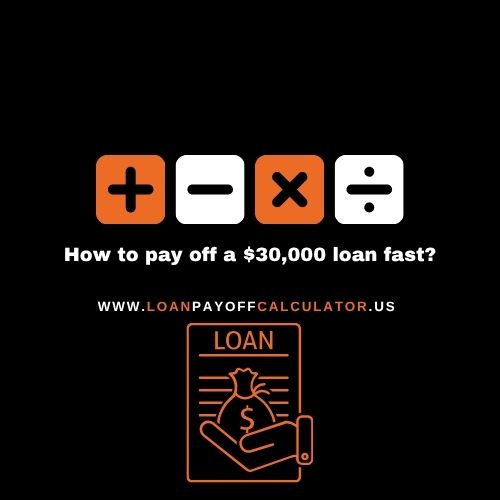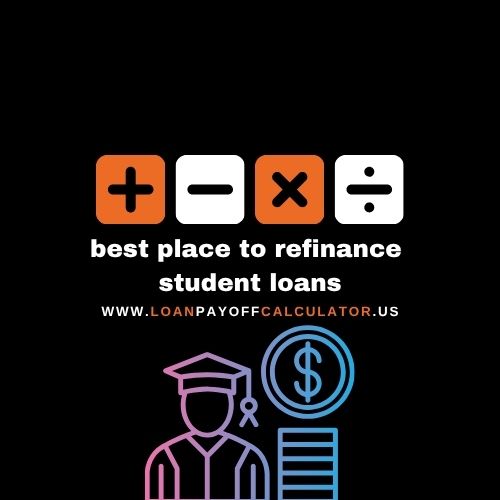How to Pay Off a $30,000 Loan Fast – Smart Strategies That Work
Many Americans carrying a $30,000 loan are looking for the fastest way to cut interest and get out of debt sooner. The good news: a few deliberate moves—extra payments, bi-weekly schedules, or a well-timed lump sum—can shave months off your timeline and save thousands.
In this guide, we’ll walk you through the step-by-step strategies, the math behind the savings, and the common mistakes to avoid, plus clear examples so you can see exactly how much you could save.
If you’ve been wondering how to pay off a $30,000 loan fast, this guide breaks it all down—simply and practically.
Understanding the Challenge of a $30,000 Loan
Taking on a $30,000 loan might seem manageable at first, but over time the interest charges can turn it into a serious financial burden. Large balances usually mean longer repayment terms—5, 6, or even 7 years—which increases the total cost of borrowing.
For example, a $30,000 loan at 7% APR over 60 months will cost more than $6,000 in interest alone. That’s money that could have gone toward savings, investments, or other important goals.
The bigger the loan and the longer the term, the more crucial it becomes to understand how interest adds up—and why finding faster payoff strategies can save you thousands.
Extra Monthly Payments: Cut Years Off Your Loan
Every extra dollar you send toward the principal reduces your interest costs and shortens your payoff timeline.
Example below: $30,000 loan, 60 months, 7% APR (baseline monthly payment ≈ $594).
| Plan | Monthly Pay | Months | Total Interest | Time Saved | Interest Saved |
|---|---|---|---|---|---|
| Baseline (no extra) | $594 | 60 | $5,642 | — | — |
| + $100 extra / mo | $694 | 50 | $4,670 | 10 mo | $972 |
| + $200 extra / mo | $794 | 43 | $3,988 | 17 mo | $1,654 |
| + $300 extra / mo | $894 | 38 | $3,484 | 22 mo | $2,158 |
Tip: Automate your extra payment—even just $100—and watch your debt-free date move up dramatically.
Bi-Weekly Payments: One Extra Payment Each Year
With a bi-weekly schedule, you pay half your monthly payment every two weeks. Because there are 52 weeks in a year,
this creates 26 half-payments (i.e., 13 full payments) instead of 12—effectively one extra payment per year.
That extra boost goes straight toward principal, helping you pay off the loan faster.
Example: For a $30,000 loan at 7% APR over 60 months (monthly ≈ $594), switching to bi-weekly
often finishes in about 54–55 months and can save around $600–$800 in interest (results vary by lender and exact schedule).
| Plan | Payment Pattern | Estimated Months | Interest (Approx.) | Time Saved | Interest Saved |
|---|---|---|---|---|---|
| Standard Monthly | $594 × 12 / year | 60 | ≈ $5,642 | — | — |
| Bi-Weekly | $297 × 26 / year | ≈ 54–55 | ≈ $4,900–$5,050 | ~ 5–6 mo | ~ $600–$750 |
Tip: If your lender doesn’t support bi-weekly drafts, you can mimic the effect by making one extra monthly payment per year
(or adding ~1/12 to each monthly payment).
Lump Sum Strategy: Use Bonuses and Refunds to Cut Debt
Another powerful way to accelerate your payoff is by making a lump sum payment. Tax refunds, work bonuses, or any unexpected income can be applied directly to the principal, instantly reducing the balance and interest charges.
Example: A $30,000 loan at 7% APR, 60 months. Making a $5,000 lump sum payment in year 2 can cut over
$1,500 in interest and shorten the payoff timeline by almost a year.
| Plan | Total Interest | Months to Payoff | Interest Saved |
|---|---|---|---|
| No Lump Sum | $5,642 | 60 | — |
| $5,000 Lump Sum (Year 2) | ≈ $4,100 | ~ 50–52 | ≈ $1,500+ |
Tip: Always check if your lender charges prepayment penalties before making a lump sum. Many lenders allow it with no fees.
Snowball vs. Avalanche: Which Pays Debt Off Faster (and Cheaper)?
Two popular methods can accelerate your payoff:
- Debt Snowball: Pay the smallest balance first while making minimums on the rest. When one debt is gone, roll its payment to the next. Best for motivation and quick wins.
- Debt Avalanche: Pay the highest APR first (most expensive interest) while making minimums on the rest. Best for minimizing total interest.
Example Debts
• Card A: $1,200 at 25% APR (min $35) • Card B: $3,500 at 18% APR (min $80) • Loan C: $5,000 at 7% APR (min $120)
| Method | Payoff Order | Best For | Typical Outcome |
|---|---|---|---|
| Snowball | Card A → Card B → Loan C (by smallest balance) | Motivation & quick wins | Faster perceived progress; may pay more interest vs. Avalanche |
| Avalanche | Card A → Card B → Loan C (by highest APR) | Minimizing total interest | Usually lowest total interest; sometimes slightly longer to first win |
Tip: For large balances, Debt Avalanche generally saves more money overall. If you need momentum to stay consistent, start with Debt Snowball—then switch to Avalanche once you’ve cleared the first debt.
Case Study: How Fast Can a $30,000 Loan Disappear?
Let’s compare three realistic payoff paths for a $30,000 loan at 7% APR. Baseline term is 60 months
(standard amortization). Numbers below are rounded to keep things easy to read.
| Scenario | Monthly Pattern | Months to Payoff | Total Interest (≈) | Time Saved | Interest Saved (≈) |
|---|---|---|---|---|---|
| Case 1 — Baseline | Monthly ≈ $594 | 60 | $5,642 | — | — |
| Case 2 — +$300 Extra / Month | Monthly ≈ $894 | ≈ 38 | ≈ $3,484 | ≈ 22 mo | ≈ $2,158 |
| Case 3 — $5,000 Lump Sum (Year 2) + Bi-Weekly | Half-payment every 2 weeks + $5,000 one-time | ≈ 44–46 | ≈ $3,100–$3,300 | ≈ 14–16 mo | ≈ $2,300–$2,500 |
Notes:
- Figures are rounded estimates for clarity; your lender’s schedule may vary slightly.
- Bi-weekly = 26 half-payments/year (13 full payments), which adds one extra payment annually toward principal.
- Lump sum applied earlier saves more interest; check for any prepayment penalties first.
Try Our Exclusive Loan Tools — Built for Smarter Payoff
These free, premium-grade calculators were designed for real borrowers like you.
Plan faster student loan payoff, reduce interest, and compare repayment strategies with ease.
Loan Payoff Calculator →
Loan Interest Calculator
Loan Comparison Calculator
Loan Refinance Calculator
No guesswork. No hidden fees. Just the smartest way to manage any loan payoff.
Common Mistakes to Avoid When Paying Off a Loan
A smart payoff plan can save you thousands, but only if you avoid these common mistakes that many borrowers make:
- Relying only on minimum payments → stretches a $30,000 loan into years longer and adds thousands in interest.
- Ignoring fees or penalties → late fees and prepayment penalties can eat up your savings if you’re not careful.
- Refinancing the wrong way → extending the term may lower your monthly payment, but it can increase the total interest cost.
- Overlooking fine print → some lenders add insurance, admin fees, or hidden charges that raise your APR without you noticing.
⚠️ Tip: Always read the full loan agreement and use a loan payoff calculator before signing. This way, you’ll know the real cost and avoid nasty surprises.
Keywords: loan payoff mistakes, refinance risks, avoid loan traps.
FAQs About Paying Off a $30,000 Loan
Here are some of the most common questions Americans ask about managing and paying off a $30,000 loan. These quick answers can guide your next steps:
1. How long to pay off a $30,000 loan?
At 7% APR with standard monthly payments, a $30,000 loan typically takes 60 months (5 years). Extra payments can shorten this to under 4 years.
2. How much interest on a 30k loan at 7%?
Over 5 years, interest will be about $5,600. Adding just $200/month extra can reduce interest by more than $1,600.
3. Is it better to pay off a loan early or invest?
Paying off early is guaranteed savings (you avoid interest). Investing may offer higher returns, but also higher risk. Many Americans combine both: extra loan payments + retirement investing.
4. Can I use debt snowball for large loans?
Yes, but debt snowball is most effective if you have multiple smaller debts. For one big $30k loan, avalanche (highest interest first) usually saves more money.
5. Does refinancing help on a 30k loan?
Refinancing to a lower APR can save thousands in interest. For example, dropping from 7% to 5% APR on a $30,000 loan saves over $1,100 in total costs.
Conclusion: How to Pay Off a $30,000 Loan Fast
Paying off a $30,000 loan fast requires a smart plan. Whether you add extra monthly payments, switch to bi-weekly payments, or make a lump-sum payoff, each strategy can save you thousands of dollars in interest and cut years off your repayment timeline.
The right approach depends on your income, expenses, and financial goals—but the key is consistency. Even small extra contributions can have a big impact over time.
📖 For more guidance, visit the official
CFPB – Getting Out of Debt Guide
.







